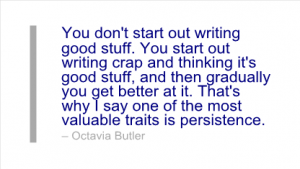
The first draft is where we capture the heart, the guts, the essence, and the power of our story. But first drafts (at least MY first drafts) are awkward, self-absorbed, disjointed and repetitious (not to mention riddled with grammatical errors.) Revision is needed — yet caution is also needed so that the best parts, the soul of what you intend to say, doesn’t get thrown out with the bath water.
I typically revise my manuscripts many, many times. Maybe others can get it right in fewer tries, but for me it takes multiple revisions. For me, the second draft is crucial — just as important as the uninhibited brain storm that is the first draft. The second revision feels like I’m standing at a fork in the road. I have a beating heart, a living idea, but it could take on many guises; I could go in many directions with this hot, pulsating mass of words. After the second draft, I’m pretty well set on my path. The more I revise, the harder it is to make drastic changes. And sometimes that’s what is needed most — a complete make-over. My advice is to keep your first draft because if you need to start over you’ll still have that wild, imperfect, passionate heart to drive your story.
If you have the luxury of TIME, it’s best to give a few days or weeks of rest between drafts. This allows your subconscious mind the opportunity to look at the story from a wider perspective. Resist the urge to cut anything on the second draft. Instead, add to it. Flesh out your idea. Play with multiple viewpoints, if you’re writing fiction, or multiple audiences, if you’re writing nonfiction. Take your time.
I’m a great believer in printing out first and second drafts. It might seem like a waste of paper, but believe me, those trees will not have died in vain. With a hard copy in hand you can cross out and highlight, you can write notes in the margins, you can give dimension and expression to your rewrite that you can’t do on the keyboard. I have a feeling most young writers are rushing through their work, eager to see it published. Most of our manuscripts benefit from a slower pace and careful revisions. In fact, the revision process never really ends; at some point a deadline approaches and you declare it finished. I’m sure most of us could continually revise one story our entire lives and when we died it would be an entirely different story from the one we started with.
On the eve of my keynote speech to the Society for Marketing Professional Services (SMPS) Marketing Excellence Awards Banquet in Denver, Colorado, I am looking at a talk quite different from the first draft I shared in an earlier post. Yet the heart and the soul of it remains. In telling my story I aim to inspire others to find the edge, to take risks, and to share their story.
